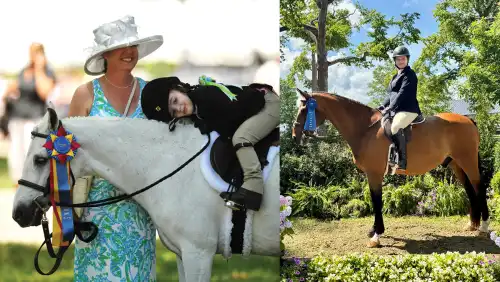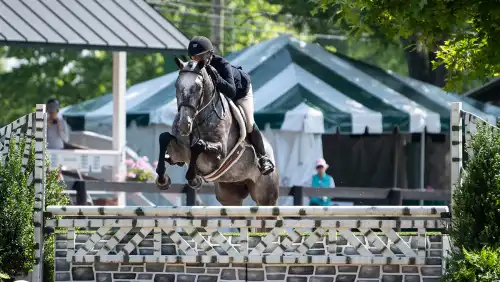For Kent Farrington, the point of walking a course is to get an idea for where the jumps sit in the ring and where he can be the fastest. As the winner of more than 15 grand prix events in 2007 and partner to the Chronicle’s Show Jumping Horse of the Year, Up Chiqui (Feb. 1, p. 52), Farrington knows how to be fast.
Here he’ll tell you what to look for when walking a high junior jumper course (this one at the CN Winter Equestrian Festival, in Wellington, Fla., and designed by Richard Jeffery) and tips that you can use the next time you tackle a course—including rollbacks, triple combinations and wide plank oxers. Just remember—don’t over think it!
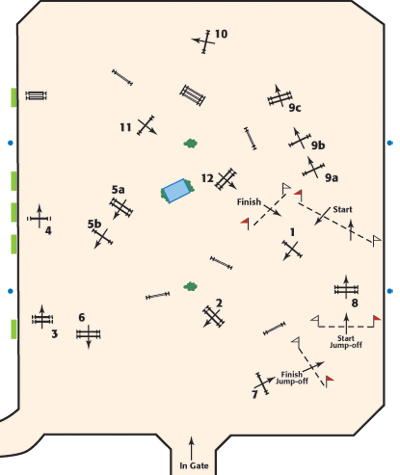
First off, coming into the ring, I would see the triple combination. It has a (Zimmerman Advertising) box underneath the middle element, which can be different. I would make sure that I move my horse through there once [before I start the course] so that when I’m riding the combination, he’s seen it, and it’s not something he’s going to spook at. If there’s a water fence that I know my horse might look at, I’ll show him that too. Really, I think a lot of walking a course is totally going to change depending on the horse that you have to ride.
The first line looks pretty inviting in six strides. You need make sure that on the first line of the course, once you jump the first jump (a vertical here), you close up the distance. This is so that you’re not far away from the first oxer (the second jump), and your horse doesn’t have to stretch too much.
The next oxer (fence 3) is a little bit wider going away from the gate, and it’s early on in the course. Early in the course, you want to make sure your horse is jumping across and that you’re going forward. After the first line, make sure your horse is going forward and make sure you have your horse ahead of your leg so that they have enough power to get across the back rail at the next oxer.
The line (fences 3 to 4) walks a touch long in five strides. If you are on a very small horse that likes to add a stride, you could do six strides. For younger riders, I would have them do five strides. It’s a little less complicated, especially after a bigger oxer coming into a line coming away from the gate. You’ll probably have to ride up a little, but that would keep your forward pace going.
After this line is a rollback to a combination with blue and yellow sailboats (fence 5AB). I’d say the inside turn is necessary for the time allowed, especially in a classic or grand prix-type class. After the line, make sure again that your horse is going forward and ahead of your leg in the turn to the combination. It’s easier to see a distance if your horse is going forward. That way, if you make a little bit of a mistake to the A element, you make it going forward and still have the impulsion to get through the one-stride.
The combination walks right on in one stride, which is pretty uncomplicated. After the one stride, look left to the next oxer (fence 6). It rides in a bending five strides. Most horses coming toward the gate will pick up on that pretty easy. I don’t see that line as being a problem.
ADVERTISEMENT
Next on the course is the Animal Planet fence 7 by the gate. Since it’s close after the last line, you need to ride it smoother. At this point, halfway through the course, you need to be watching the time allowed a little bit. It’s an easy place to have time faults through here if you start adding strides as you go past the in-gate.
This next line and the line to the triple combination is more horse-specific than any. From the Animal Planet vertical (fence 7) to the oxer (fence 8), it walks a little long in seven strides. I think a big mover would do seven strides and maybe a smaller horse would go out wide in eight strides. This is an important point in the course where you need to make a decision based on the kind of horse you are riding, and it’s where you have to make a decision for yourself. Your trainer can tell you a number, but it’s up to you as the rider to decide what will work when you’re heading down to a fence.
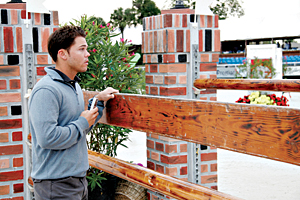 Off of that bending line (fence 7 to 8) that is seven or eight strides, this is another horse-specific line from jump 8, an oxer, to jumps 9ABC. With it being a vertical-vertical-oxer combination starting with a short one-stride, it’s an option of doing seven strides down to the combination. I also see a possibility of doing eight strides depending on the horse. If your horse jumps bigger, you can bend out and do the eight strides before the combination. Walking this course with a young rider, it would depend on the horse she’s riding. I think with a big-strided horse, it’s a lot less complicated just to look in and stay on a smooth seven strides. If the rider is more advanced and has a smaller horse, I would go out wide and do eight strides.
Off of that bending line (fence 7 to 8) that is seven or eight strides, this is another horse-specific line from jump 8, an oxer, to jumps 9ABC. With it being a vertical-vertical-oxer combination starting with a short one-stride, it’s an option of doing seven strides down to the combination. I also see a possibility of doing eight strides depending on the horse. If your horse jumps bigger, you can bend out and do the eight strides before the combination. Walking this course with a young rider, it would depend on the horse she’s riding. I think with a big-strided horse, it’s a lot less complicated just to look in and stay on a smooth seven strides. If the rider is more advanced and has a smaller horse, I would go out wide and do eight strides.After the triple combination is a vertical set at the end of the ring. It walks in about 6 1/2 strides. I think this jump will come up quickly, especially having to ride out of the triple with a short one-stride to a little bit of a scopier two-stride with an oxer coming out. I’d say seven strides is the number, if you’re counting. Here is where you need to slow down and have your horse’s balance correct for the vertical at the end of the ring. Don’t worry so much about how many strides you’re doing.
With the last line coming home toward the in-gate, there’s one of the tallest verticals on the course. The last line is where you want to make sure you’re not rushing. If you’re going clear, you don’t want to get too anxious. You want to keep the same rhythm and not let your horse start picking up speed toward the end of the course. They can feel your adrenaline as you’re coming home, so stay calm. You want to be slow with your upper body at a tall vertical. The next fence is a plank oxer, so really make sure you’re not rushing your upper. You want to ride the last line as if there’s another fence on course afterward, like you have something else to think about, not that you’re almost going clear.
The last line walks right on in five strides to a square oxer, one of the widest oxers on the course. This is another point that a rider should be aware of—which jump is the tallest? Which is the widest? These things come into play depending on where they are in the course and what fences come after them and before them. Also, look at how the actual jump is designed. Is it on extremely flat or upside down cups? Is there a wall underneath? Is it extremely airy? Take these things into consideration depending on what you think your horse’s reaction to them will be.
With a plank being in front of the final oxer on course, you want to make sure you don’t push the horse to the front of the oxer. I would definitely do the five strides. There’s no real option here. Make sure you jump the vertical clear before you think about the five strides. The horse will be taking you home at the end of the course, so it should be pretty easy for them to take you up to the back rail of the oxer. Try not to rush the front of the oxer. Make your way through the timers, and you’re clear in the first round.
The Jump-Off
ADVERTISEMENT
The jump-off starts with one of the lines on the course where we did a seven or maybe a possible adding eight strides into the triple combination. This time, you’re starting with fence 8 and only jumping the A element of fence 9, a vertical. For the jump-off, you should go with the lesser stride option. Here, it’s seven strides unless you’re on a huge mover. If you’re very ambitious, there’s a possible six. You’re only doing the first element of the combination and then making a left turn to fence 12, which was the wide plank oxer.
The next oxer is wide enough, so don’t roll back too short to that. With it having a plank on the front, and like I said, being one of the widest oxers on the course, it’s possible sometimes for course designers to take this fence and make it a skinny in the jump-off. After the first round is finished and you’re advancing to the jump-off, you should try to watch and see if the course designer changes a fence or leaves it the way it is. If they leave it the way it is, then off of the second fence you should make sure to ride your horse forward before you go into the turn so that you have enough power for the back rail of the oxer. This is another example of being aware and watching what’s going on in your class. If the course designer takes out jumps, some turns become easier. They can also raise or widen fences, which you should be aware of.
It’s a pretty long way away to the next oxer, which was originally fence 2. I wouldn’t count strides there or worry about a number. Just stay on a tight line and stay on a smooth rhythm.
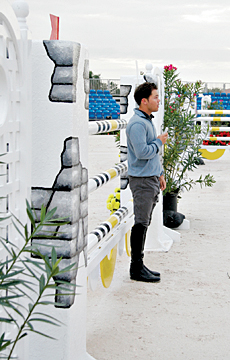
Then comes a place where you can win the class. I wouldn’t get a flying distance at this oxer, so that you’re deep enough to make the inside turn, inside of fence 6. This line to the next jump, fence 4, is a place where I’m thinking about running. You can open up your step a lot here.
You can make up a lot of time over to that vertical; run across the ring and then slow down. In a jump-off, you can’t be at the end of your step (with the biggest stride possible) at the fence, especially at a tall vertical before a short rollback to a combination. You can run across the ring and keep your balance the same, but don’t rush your horse at the vertical.
When you land off the fence 4, make sure your horse moves forward off your leg before you roll back to the combination at fence 5ab (the blue and yellow). I don’t think this is a place to really make up a ton of time. It’s sort of a spooky in-and-out, with a one-stride distance and an oxer coming in. You can’t turn that short.
So, have a medium turn, do the one stride, and then it’s a little bit of a race to a careful last fence, fence 7. It’s the same situation as the number 4 vertical—don’t rush.
Article and photos by Jennifer Wood









